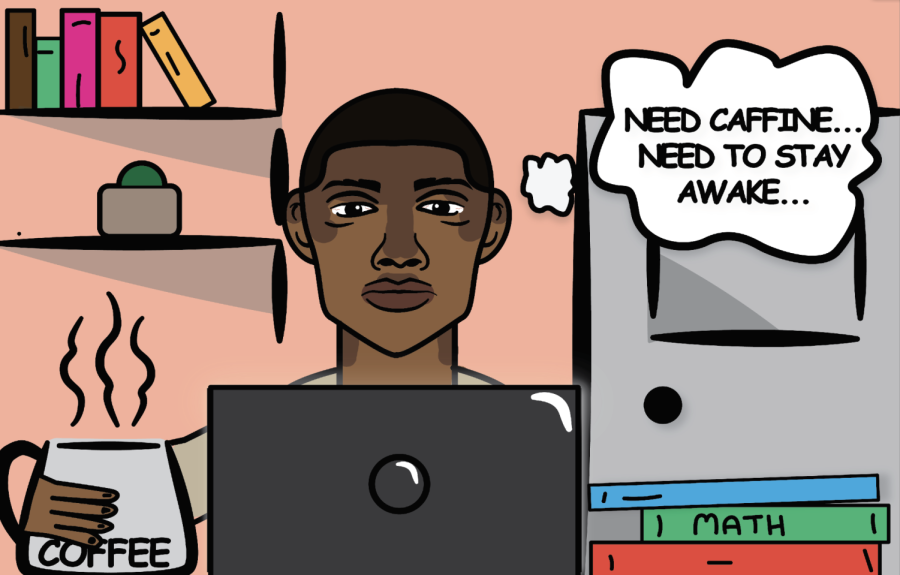Caffeine: a student secret to success
As school gets tougher, caffeine may be the only way to keep going
Knowing your body and your limits is important to maintain a healthy life; we should keep this in mind when consuming things like caffeine.
March 22, 2023
You drag yourself out of bed, after a grueling night of homework and stress, trying to grasp that you now have to make it through another harsh day at school. You know the only thing that could put you in a better mood is your tasty, morning energy drink. It might be the only thing you’re looking forward to as you start your school day.
The same could be said for about the three-quarters of American kids who consume caffeine on a daily basis. And, while the American Academy of Pediatrics recommends teens to consume less than 100 mg a day, which approximates an eight-ounce cup of coffee, it’s easy to see how quickly caffeine intake can add up when considering the consumption of energy drinks and local coffee shop brews. But is it a bad thing for teenagers? And should it be limited?
Well, I think that caffeine is all relative to the person who consumes it. For many, it is a necessity that keeps them going when they have no energy left to give. For others, it makes them too hyperactive to focus on what they need to be doing or carrying about their day. So, in this case, we must first consider the positive aspects of caffeine consumption.
First of all, as a stimulant, caffeine will make one more alert and boost overall awareness. It has also been proven to help one process information faster. Moreover, there’s an undeniable academic benefit here, given what high school students are expected to do all day. Something that can improve focus and give you more mental energy? That sounds like caffeine for the win.
Caffeine has also been shown to improve one’s mood. So, we shouldn’t think about removing that from teenagers’ daily lives. It’s also doubtful that teachers want to deal with even grumpier kids with shorter attention spans. And how many adults would want to give up their own sources of caffeine, given the health benefits to them as well?
However true, not all things about caffeine consumption are positive. Some potential side effects include insomnia, restlessness, diuresis, upset stomach, and even cardiac arrhythmia (irregular heart rhythms). But it’s also important to understand that some people are more sensitive to caffeine than others. It comes down to understanding one’s health and risk profile, and how an individual reacts to caffeine.
Indeed, caffeine consumption by coffee drinkers also has been proven to provide major health benefits, as studies with adults by the John Hopkins University School of Medicine have confirmed. Coffee drinkers are actually less likely to die from coronary heart disease, stroke, diabetes, and kidney disease.
Caffeine has also been associated with a lower chance of developing Parkinson’s disease and Alzheimer’s disease. Not only this but, researchers have found favorable enzyme levels in the livers of those who drink coffee, compared to those who do not. Even colorectal cancer risk appears lower for coffee drinkers.
Perhaps some of the difficulties with caffeine consumption come from what it’s commonly paired with: sugar. For example, a grande Vanilla Frap from Starbucks contains 430 calories and 95 mg of caffeine. Size up to a Venti, and that’s 530 calories and 125 mg of caffeine.
Additionally, a typical energy drink contains around 40 grams of sugar and 160 mg or more of caffeine. For example, a Monster Energy drink contains 57 g of sugar, and 160mg of caffeine while, a Rockstar Punched Energy Guava flavored drink contains 83.5 g (equivalent to 21 teaspoons) of sugar and 160 mg of caffeine.
Furthermore, If someone is trying to limit caffeine intake, particularly late in the day, there are a number of unexpected sources of caffeine to watch out for. For many of us, we could be taking in caffeine without even knowing were doing it.
One of these surprising sources of caffeine is certain over-the-counter pain relievers that also contain ibuprofen, frequently for treating headaches. Snack bars may also include caffeine in the form of coffee beans, matcha, cacao, or even green tea extract. Even “decaffeinated” coffee contains some amount of caffeine – up to 15 mg depending on quantity.
Teenage deaths related to caffeine have also led to a stigma, however, as long as you are taking in a healthy amount of caffeine, tragedies like this cannot happen. Teenagers and adults alike just need to be more aware of the amount of caffeine they are consuming whether in caffeinated drinks or in over-the-counter pain relievers.
Ultimately, as with so many things in life, moderation is key. And, given the large number of other dangers lurking out there for teenagers in this day and age, is it really fair to call attention to something as relatively harmless as caffeine? Especially when it might be the one thing that gets high school students to school on time and in a better mood than when they rolled out of bed. Knowing your body and your limits is important to maintain a healthy life; we should keep this in mind when consuming things like caffeine.










